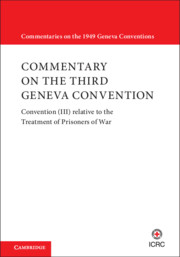 Commentary on the Third Geneva Convention
Commentary on the Third Geneva Convention from Chapter IV - Medical Personnel and Chaplains Retained to Assist Prisoners of War
Published online by Cambridge University Press: 21 August 2021
Article 33 is the centrepiece of the regime for the retention ofmilitary medical and religious personnel (covered by Article 24 of theFirst Convention) and staff of voluntary aid societies employed on thesame duties (covered by Article 26 of the First Convention) ininternational armed conflicts. Article 33 needs to be read together withArticles 28, 30 and 31 of the First Convention, where retention based onArticle 28 is contemplated as an exception to the rule, set out inArticle 30, requiring the return of such personnel to the Party to theconflict to which they belong. The special treatment to which qualifyingpersonnel are entitled under this provision is designed to ensure thatprisoners of war receive the necessary medical and spiritual care. Theparts of Article 33 pertaining to the status, treatment and facilitiesdue to retained medical personnel and chaplains appear almost word forword in Article 28 of the First Convention.
To save this book to your Kindle, first ensure [email protected] is added to your Approved Personal Document E-mail List under your Personal Document Settings on the Manage Your Content and Devices page of your Amazon account. Then enter the ‘name’ part of your Kindle email address below. Find out more about saving to your Kindle.
Note you can select to save to either the @free.kindle.com or @kindle.com variations. ‘@free.kindle.com’ emails are free but can only be saved to your device when it is connected to wi-fi. ‘@kindle.com’ emails can be delivered even when you are not connected to wi-fi, but note that service fees apply.
Find out more about the Kindle Personal Document Service.
To save content items to your account, please confirm that you agree to abide by our usage policies. If this is the first time you use this feature, you will be asked to authorise Cambridge Core to connect with your account. Find out more about saving content to Dropbox.
To save content items to your account, please confirm that you agree to abide by our usage policies. If this is the first time you use this feature, you will be asked to authorise Cambridge Core to connect with your account. Find out more about saving content to Google Drive.